Hello, I’m Caro. I’m an Instructional Designer at ADInstruments. Every month our team of Instructional Designers meets for “Talking Teaching” – sessions where we share and discuss interesting articles, methods, and pedagogies. This month, we discussed how learning might be influenced by technological advances in artificial intelligence (AI). In this blog, I’d like to discuss the concept of personalized learning and how technological advances in AI might influence the future of learning.
The two articles we’d like to share with you this month:
What is personalized learning?

Personalized learning is a growing topic in today’s K-12 education. It describes a broad concept of learning that can be subdivided into the personalization of content, the personalization of pace and progress, and the personalization of process. An increasing number of schools are exploring ways to personalize learning material, learning speed, and learning media for each student as the ‘one size fits all’ approach does not appear to be benefiting students’ achievements. For example, one student might excel at math but has difficulty learning new languages as they prefer to learn visually. While another student might be the opposite. Different approaches are required to best support both students’ learning. This is what personalized learning aims to do; provide the best possible educational journey for each student.
Why personalized learning?
Increasing class sizes and increased diversity between students (out-of-curriculum commitments, language, background, etc) has pushed the education system into a new normal. In order to address increased diversity, more educators are needed to provide individualized support to students. However, educators and their time are limited. A way of implementing an individualized learning environment is through technology, that is, using AI to personalize every student’s learning journey. Technology can provide each student with individual learning material based on their knowledge gaps, learning pace and preferences. Likewise, the educators are able to more easily track students’ progress.

Technology can provide each student with individual learning material based on their knowledge gaps, learning pace and preferences.
How can AI help?
AI is embedded in various software and platforms with many companies’ founding vision to make students’ learning experiences more personal and successful. For example, some schools use platforms (e.g. Altitude learning) where the educator can create individual learning paths for each student based on the student’s level. At the same time, this platform monitors students’ progress. Other software (Newsela) actively promotes students’ literacy by providing texts at different difficulty levels to accommodate a variety of language skills. This helps students build confidence, increases inclusion, and increases literacy. Another software (DreamBox Learning) increases students’ math understanding by specifically providing problems on the individual students’ level, which helps slowly build up expertise. AI could not only be used to aid students but also to facilitate the educator’s job, e.g. it could be used for automated essay scoring or analytical dashboards.
Pros and cons of personalized learning
Much research has been conducted to determine if personalized learning is effective with no conclusive results. Some literature suggests that students are more motivated to learn when the material actually interests them compared to the pre-set curriculum. It has also been reported that personalized learning potentially leads to higher student retention because every student is supported on his/her level and therefore won’t feel overwhelmed. Learning will be more inclusive for students with language barriers and disabilities. A more flexible teaching environment makes it easier to adapt to students’ busy lives and other commitments. On the contrary, personalized learning might lead to less social interaction and subsequent behavioral issues. As personalized learning is commonly supported by technology, it might also lead to an increase in inequalities. Lastly, educators might find it more difficult to grade students and compare the amount of learned content between students. Could an increase in personalized learning lead to a push towards learning skills and not facts?
Is AI the future of learning?
With all the benefits of personalized learning, is AI the future of the education system? More research has been conducted to answer this question. Personalized learning has proven to be difficult to apply in public school systems due to poor access to technology. Currently, there is little evidence that personalized learning actually increases students’ success rates. There is a lot of potential for AI to be an aide for teachers to enable them to focus more on supporting students, however, we are not at a stage of completely self-guided learning yet.
Join the discussion
Are you currently using any form of AI in your classroom? How does it influence your students’ performance? Join us in the ADI: Educator Community on LinkedIn and let other educators know your thoughts!
Our online community is a hub for life sciences education in #highered, where you can share resources, ask questions, get feedback, and build meaningful relationships - across campus and across the globe!
Additional Resources
How to make online assessments resistant to cheating »
10 Tips for Teaching Online – How to successfully teach remotely and keep your students engaged »
How to Improve Digital Literacy in Course Design »
